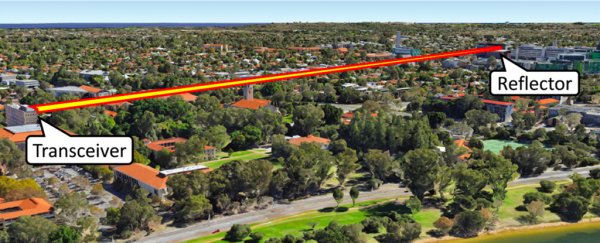Scientists are on a mission to create a global network of atomic clocks that will enable us to, among other things, better understand the fundamental laws of physics, investigate dark matter, and navigate across Earth and space more precisely.
However, to be at their most effective, these clocks will need to be reliably and speedily linked together through layers of the atmosphere, which is far from easy. New research outlines a successful experiment with a laser beam that has been kept stable across a distance of 2.4 kilometers (1.5 miles).
For comparison, the new link is around 100 times more stable than anything that's been put together before. It also demonstrates stability that's around 1,000 times better than the atomic clocks these lasers could be used to monitor.
"The result shows that the phase and amplitude stabilization technologies presented in this paper can provide the basis for ultra-precise timescale comparison of optical atomic clocks through the turbulent atmosphere," write the researchers in their published paper.
The system builds on research carried out last year in which scientists developed a laser link capable of holding its own through the atmosphere with unprecedented stability.
In the new study, researchers shot a laser beam from a fifth-floor window to a reflector 1.2 kilometers (0.74 miles) away. The beam was then bounced back to the source to achieve the total distance for a period of five minutes.
Using noise reduction techniques, temperature controls, and tiny adjustments to the reflector, the team was able to keep the laser stable through the pockets of fluctuating air. The atmospheric turbulence at ground level here is likely to equate to ground-to-satellite turbulence (the air is calmer and less dense higher in the atmosphere) of several hundred kilometers.
While laser accuracy has remained fairly constant for a decade or so, we've seen some significant improvements recently, including a laser setup operated by the Boulder Atomic Clock Optical Network (BACON) Collaboration and tested last March.
That setup involved a pulse laser rather than the continuous wave laser tested in this new study. Both have their advantages in different scenarios, but continuous wave lasers offer better stability and can transfer more data in a set period of time.
"Both systems beat the current best atomic clock, so we're splitting hairs here, but our ultimate precision is better," says astrophysicist David Gozzard from the University of Western Australia.
Once an atomic clock network is put together, among the tests scientists will be able to perform is Einstein's general theory of relativity, and how its incompatibility with what we know about quantum physics could be resolved.
By very precisely comparing the time-keeping of two atomic clocks – one on Earth and one in space – scientists are eventually hoping to be able to work out where general relativity does and doesn't hold up. If Einstein's ideas are correct, the clock further away from Earth's gravity should tick ever-so-slightly faster.
But its usefulness doesn't stop there. Lasers like this could eventually be used for managing the launching of objects into orbit, for communications between Earth and space, or for connecting two points in space.
"Of course, you can't run fiber optic cable to a satellite," says Gozzard.
The research has been published in Physical Review Letters.
